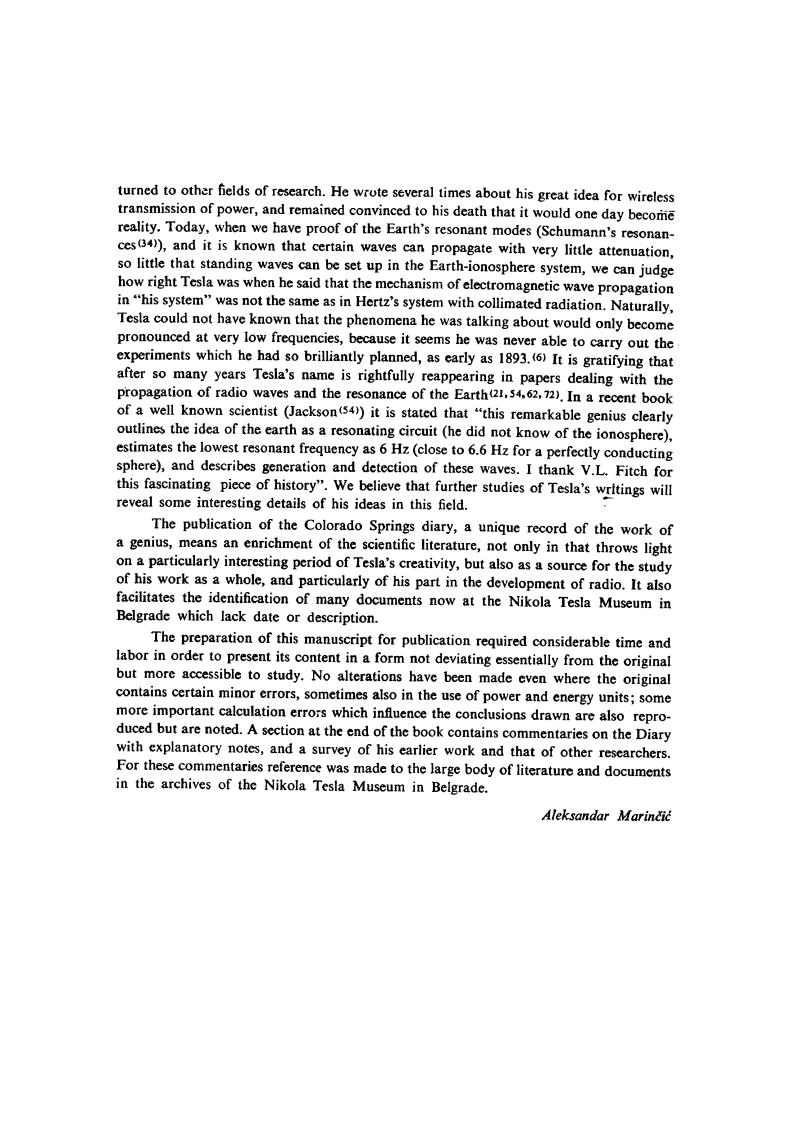
Nikola Tesla Books
turned to other fields of research. He wrote several times about his great idea for wireless transmission of power, and remained convinced to his death that it would one day become reality. Today, when we have proof of the Earth's resonant modes (Schumann's resonances(34)), and it is known that certain waves can propagate with very little attenuation, so little that standing waves can be set up in the Earth-ionosphere system, we can judge how right Tesla was when he said that the mechanism of electromagnetic wave propagation in âhis systemâ was not the same as in Hertz's system with collimated radiation. Naturally, Tesla could not have known that the phenomena he was talking about would only become pronounced at very low frequencies, because it seems he was never able to carry out the experiments which he had so brilliantly planned, as early as 1893.(6) It is gratifying that after so many years Tesla's name is rightfully reappearing in papers dealing with the propagation of radio waves and the resonance of the Earth(21, 54, 62, 72). In a recent book of a well known scientist (Jackson(54)) it is stated that âthis remarkable genius clearly outlines the idea of the earth as a resonating circuit (he did not know of the ionosphere), estimates the lowest resonant frequency as 6 Hz (close to 6.6 Hz for a perfectly conducting sphere), and describes generation and detection of these waves. I thank V.L. Fitch for this fascinating piece of historyâ. We believe that further studies of Tesla's writings will reveal some interesting details of his ideas in this field.
The publication of the Colorado Springs diary, a unique record of the work of a genius, means an enrichment of the scientific literature, not only in that throws light on a particularly interesting period of Tesla's creativity, but also as a source for the study of his work as a whole, and particularly of his part in the development of radio. It also facilitates the identification of many documents now at the Nikola Tesla Museum in Belgrade which lack date or description.
The preparation of this manuscript for publication required considerable time and labor in order to present its content in a form not deviating essentially from the original but more accessible to study. No alterations have been made even where the original contains certain minor errors, sometimes also in the use of power and energy units; some more important calculation errors which influence the conclusions drawn are also reproduced but are noted. A section at the end of the book contains commentaries on the Diary with explanatory notes, and a survey of his earlier work and that of other researchers. For these commentaries reference was made to the large body of literature and documents in the archives of the Nikola Tesla Museum in Belgrade.
Aleksandar MarinÄiÄ
Tesla: âOn light and other high frequency phenomenaâ, a lecture delivered before the Franklin Ins. Philadelphia, Febr. 1893, L-107.
Wait, J.R. âHistorical background and introduction to the special issue on extremely low frequency (ELF) propagationâ, IEEE Trans. on Communications, Vol. COM-22, No. 4, April 1974.
Galeys J. TERRESTRIAL PROPAGATION OF LONG ELECTROMAGNETIC WAVES, New York, Pergamon Press, 1972.
Jackson J.D. CLASSICAL ELECTRODYNAMICS, John Wiley, 1975, New York.
ÐаÑинÑÐ¸Ñ Ð. "ТеÑла один из оÑновоположников ÑовÑеменой ÑлекÑÑоÑÐµÑ Ð½Ð¸ÐºÐ¸", ÐопÑоÑÑ Ð¸ÑÑоÑии еÑÑеÑÑÐ²Ð¾Ð·Ð½Ð°Ð½Ð¸Ñ Ð¸ ÑÐµÑ Ð½Ð¸ÐºÐ¸, Ðк ad. ÐаÑк, СССР, ÐоÑква, 1976, ÐÑпÑÑк 2 (55)
English: Marinchy A. "Tesla is one of the founders of modern electrical engineering", Questions of the history of natural science and technology, Acad. Nauk, USSR, Moscow, 1976, Issue 2 (55)
Wait J.R. âPropagation of ELF electromagnetic waves and project Sanguine/Seafarerâ, IEEE Jour, of Ocean. Eng., Vol OE-2, No. 2, April 1977.

